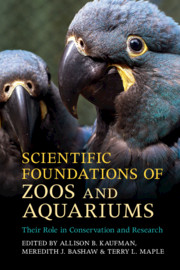15 results
Index
-
- Book:
- Scientific Foundations of Zoos and Aquariums
- Published online:
- 21 December 2018
- Print publication:
- 03 January 2019, pp 663-670
-
- Chapter
- Export citation
In Memoriam
-
- Book:
- Scientific Foundations of Zoos and Aquariums
- Published online:
- 21 December 2018
- Print publication:
- 03 January 2019, pp v-vi
-
- Chapter
- Export citation
Contents
-
- Book:
- Scientific Foundations of Zoos and Aquariums
- Published online:
- 21 December 2018
- Print publication:
- 03 January 2019, pp ix-xii
-
- Chapter
- Export citation
9 - Empowering Zoo Animals
- from Part II - Captive Care and Management
-
-
- Book:
- Scientific Foundations of Zoos and Aquariums
- Published online:
- 21 December 2018
- Print publication:
- 03 January 2019, pp 241-273
-
- Chapter
- Export citation
Epigraph
-
- Book:
- Scientific Foundations of Zoos and Aquariums
- Published online:
- 21 December 2018
- Print publication:
- 03 January 2019, pp vii-viii
-
- Chapter
- Export citation
Part IV - Basic Research
-
- Book:
- Scientific Foundations of Zoos and Aquariums
- Published online:
- 21 December 2018
- Print publication:
- 03 January 2019, pp 475-645
-
- Chapter
- Export citation
Part III - Saving Species
-
- Book:
- Scientific Foundations of Zoos and Aquariums
- Published online:
- 21 December 2018
- Print publication:
- 03 January 2019, pp 325-474
-
- Chapter
- Export citation
Part I - Programs and Initiatives
-
- Book:
- Scientific Foundations of Zoos and Aquariums
- Published online:
- 21 December 2018
- Print publication:
- 03 January 2019, pp 43-188
-
- Chapter
- Export citation
Part II - Captive Care and Management
-
- Book:
- Scientific Foundations of Zoos and Aquariums
- Published online:
- 21 December 2018
- Print publication:
- 03 January 2019, pp 189-324
-
- Chapter
- Export citation
Conclusion
-
-
- Book:
- Scientific Foundations of Zoos and Aquariums
- Published online:
- 21 December 2018
- Print publication:
- 03 January 2019, pp 646-661
-
- Chapter
- Export citation
Contributors
-
- Book:
- Scientific Foundations of Zoos and Aquariums
- Published online:
- 21 December 2018
- Print publication:
- 03 January 2019, pp xiii-xvi
-
- Chapter
- Export citation
Acknowledgments
-
- Book:
- Scientific Foundations of Zoos and Aquariums
- Published online:
- 21 December 2018
- Print publication:
- 03 January 2019, pp xvii-xviii
-
- Chapter
- Export citation
Appendix
-
- Book:
- Scientific Foundations of Zoos and Aquariums
- Published online:
- 21 December 2018
- Print publication:
- 03 January 2019, pp 662-662
-
- Chapter
- Export citation
Copyright page
-
- Book:
- Scientific Foundations of Zoos and Aquariums
- Published online:
- 21 December 2018
- Print publication:
- 03 January 2019, pp iv-iv
-
- Chapter
- Export citation

Scientific Foundations of Zoos and Aquariums
- Their Role in Conservation and Research
-
- Published online:
- 21 December 2018
- Print publication:
- 03 January 2019



